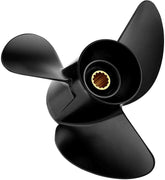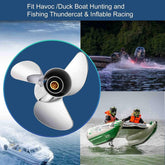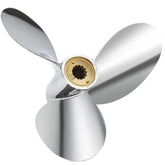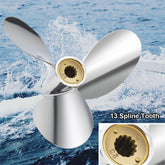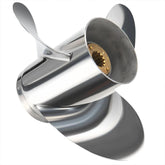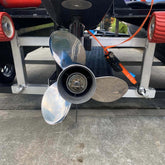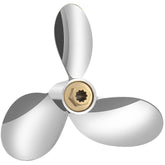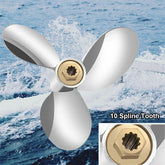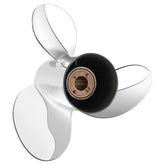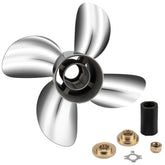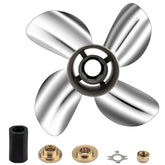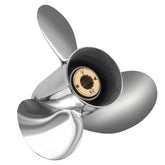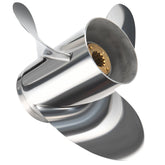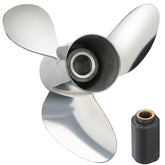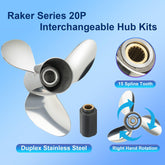How Propeller Rings, Guards and Baskets Protect Your Boat—and When to Use Them
Prop guards, rings and baskets look simple, but they change how your outboard behaves, how safe your crew is, and how often you visit the shop. For North American boaters running Mercury, Yamaha, Honda, Suzuki, Volvo or Tohatsu outboards—whether you’re a weekend angler, a rental operator, or a small commercial skipper—understanding the tradeoffs and the right application separates a smart purchase from an expensive regret.
Below is an honest, hands-on guide that explains what these devices do, which designs work with common outboards, how they affect performance, and exactly how to inspect and maintain them so they protect gear and people without creating new problems. I’ve added natural links to VIF product and factory pages so you can match what you read to parts you can actually buy: our Boat Propeller Online Store, a factory overview at boat propeller manufacturer, and the design/production read on How Boat Propellers Are Manufactured.
What propeller rings, guards and baskets are designed to do
At their core, these devices reduce direct contact between a spinning propeller and external hazards: swimmers, lines and loose objects, shallow rocks, and debris. They fall into three practical categories:
Propeller rings
A simple ring that surrounds part of the propeller arc to reduce the chance of things getting drawn into the blades. Rings are common on small aluminum props and on pontoons that risk hitting dock pilings or unseen stumps.
Propeller guards
Larger and usually more structured, guards wrap around the propeller tips. They’re frequently used on rental craft, calm-water tour boats, and shallow-water trolling setups. Guards aim to deflect objects away from blade edges while still allowing thrust.
Propeller baskets / cages
A full-coverage basket or cage is common on jet boats and some inboard/outboard configs where maximum protection from debris (weeds, rope, plastic bags) is required. Baskets block large objects from clogging the intake and damaging the prop or lower unit.
All three reduce the likelihood of a prop strike or entanglement—but they don’t make propellers invincible. Expect tradeoffs.
Why fleets, rentals and tender operators install guards (and why private owners sometimes don’t)
There are three practical drivers that make guards a clear choice for certain operators:
Safety for people
In crowded waters, near swimming areas, or on guided tours, a guard can mean the difference between a close call and a tragic accident. For charter and rental businesses, this safety margin is often a legal and reputational necessity.
Reduced downtime and repair cost
Guards reduce the number of repair shop visits for bent blades and lower-unit damage after strikes. For fleet operators that measure profitability in hours on the water, fewer repairs are huge.
Preventing entanglement
In shallow, vegetation-heavy waters and inland rivers with floatable debris, baskets and cages are lifesavers—they stop weeds and trash from wrapping the blades or blocking water flow.
Yet private owners focused on top speed and fuel economy often skip guards because:
-
Guards add wetted surface and drag, which lowers top speed and raises fuel consumption.
-
Some guards interfere with reverse thrust or trim and may change handling during docking.
-
Not every hub and lower unit accepts the same guard design—fit and rotation matter.
Use the same decision process you use for a prop change: define what you actually need (safety and durability vs speed and efficiency), then match hardware.
How prop guards affect performance — realistic expectations
People often assume a guard simply “protects” and does nothing else. That’s not true. Expect measurable differences:
Thrust and top speed
A well-designed guard can reduce top speed by a few percent on planing hulls and by more on heavier, slower hulls (pontoons). The drag increases because the guard is an extra lifting/drag surface in the water.
Acceleration and hole shot
In some cases, a guard lowers hole shot because it slightly disturbs flow into the prop. But if the guard prevents repeated blade damage, it may improve real-world acceleration over time (a nicked prop performs worse than a guarded clean prop).
Handling and steering
Guards can change how the prop ventilates at high trim angles and during hard turns. You might notice slightly different stern lift or increased stern yaw during aggressive maneuvers—this is why a quick field test after installation is essential.
Fuel economy
Expect modest increases in fuel burn at cruising speeds. The size of the penalty depends on hull type, engine HP, and guard aerodynamics.
If optimizing for top speed and fuel economy is your priority, stainless steel or precision-machined props without guards are often the best route. If safety, rental durability or debris control matter more, add a guard and accept the tradeoff.
Matching guards to engines and props: fit and mechanical checks
A guard that doesn’t fit the shaft, hub, or rotation pattern can be worse than no guard at all. Do this before you buy:
Confirm shaft, spline and hub compatibility
Guards attach to lower units with brackets that assume a particular shaft offset and spline count. Verify fit against your engine manual and the prop hub style—Mercury, Yamaha, Suzuki and others have different splines and hub shapes. If you use an aftermarket prop with an elastomer hub, check the guard clearance.
Rotation and pitch
Most single outboards are right-hand rotation; twins or counter-rotating set ups differ. Confirm guard design doesn’t interfere with expected thrust direction or the cooling water flow around the hub.
Clearance and cavitation risk
Ensure the guard provides blade tip clearance. If the guard sits too close it may cause cavitation or increased vibration. The goal is a few millimeters gap uniformly around the tip arc.
If you want pre-selected guard options that match common outboards, our Boat Propeller Online Store lets you filter by engine family (Mercury-fit, Yamaha-fit, etc.). For manufacturing detail and tolerances, check How Boat Propellers Are Manufactured.
Installation and inspection routine — a practical checklist
A guard helps only when installed and checked regularly. Adopt this short routine:
After installation
-
Confirm prop spins freely with the guard in place; no rubbing or scraping.
-
Test steering response at low speed in calm water and note any unusual vibration.
-
Run to WOT briefly in protected waters and check WOT RPM against expected band—if RPM drops unexpectedly, the guard may be causing excessive drag or flow disruption.
Monthly (active season)
-
Inspect mount bolts for looseness or corrosion.
-
Check welds and brackets for cracking or fatigue, especially if you operate in rough water.
-
Look for dents or deformation in the guard that could contact blades at high RPM.
After any strike or grounding
-
Remove and inspect the prop for bent blades, hubs and grooving. A guard often hides damage until it worsens—don’t assume the guard fixed the problem. Replace or rebalance the prop if vibration appears.
A well-maintained guard and monthly checks prevent the majority of field failures.
Field repair and propeller interaction — what you can do and what needs a shop
Field actions you can do
-
Remove trapped lines, twine, weeds or plastic from baskets/guards. Cut lines carefully to prevent shaft gouging.
-
Realign loose brackets and retorque mounting bolts per manufacturer spec.
-
If a prop nick is small, file and smooth it; if vibration persists, swap to a spare aluminum prop for the run back.
Shop repairs required
-
Bent blades or severe cupping need professional straightening or replacement.
-
Welded or cracked guards (especially stainless) should be replaced—don’t attempt structural welding unless you have marine welding expertise.
-
Shaft scoring, spun hubs and seal replacement require lower-unit work by a technician.
If you end up shopping for replacements or spares, our online catalog has hub inserts, spare aluminum emergency props, and guard-friendly prop models: visit the Boat Propeller Online Store and explore engine collections like propeller for Suzuki and propeller for Honda.
Choosing the right guard for your use case — a short decision guide
-
Rental fleets & charters: Full-coverage guards or baskets. Prioritize durability and easy inspection.
-
Shallow lakes & weeded rivers: Basket/cage designs to stop weeds and debris from wrapping.
-
Family boats near swimmers and docks: Streamlined guards to balance safety and performance.
-
Performance craft / speed focus: Minimal or no guard; keep high-precision stainless props and rely on skilled operation and propeller protectors only when necessary.
Pair a guard with an emergency aluminum spare prop and a hub insert kit so a field swap is quick and safe.
Real examples (practical outcomes owners report)
-
A pontoon rental operator switched to low-drag, cage-style baskets. Result: fewer haulouts for weed clogs, slightly slower top speed (customers didn’t mind), and much fewer prop replacements.
-
A bass-boat owner kept a slim ring guard for lake launch areas; it reduced dock strikes during low-speed maneuvers and was easily removed for tournaments where top speed mattered.
-
A guide service running heavy gear used 4-blade props with baskets; they gained steadier low-speed control and fewer trips to the prop shop despite slightly higher fuel costs.
These real tradeoffs are what you should weigh before ordering.
FAQ (short, practical answers)
What do propeller rings, guards and baskets actually stop?
They reduce blade contact with loose objects, prevent line entanglement, block large debris from jamming the intake, and lower injury risk to swimmers.
Do guards save money on prop repairs?
In most debris-heavy or shallow applications, yes—fewer blade bends and fewer lower-unit strikes translate to lower maintenance bills.
Will a guard change my boat’s speed and fuel burn?
Expect a small reduction in top speed and a modest increase in consumption—how much depends on hull type and guard aerodynamics.
Can I install a guard on any outboard?
Not automatically. Check spline/shaft/hub compatibility, rotation and clearance. Use engine-filtered parts from trusted suppliers.
Are baskets better than guards?
Baskets offer more protection from trash and weeds but add more drag. Choose based on debris risk and performance tolerance.
Closing: a balanced pick beats an impulse buy
Propeller rings, guards and baskets are safety and reliability tools—useful for rental fleets, shallow water work, and any operation where lives, gear, or uptime matter more than a few top-end miles. Pick a design that fits your engine and prop hub, install and inspect it properly, and carry the right spares. If you want guard-compatible prop candidates or a prebuilt spare kit for a specific outboard model (Mercury, Yamaha, Honda, Suzuki, Volvo, Tohatsu), I can map options from our catalog into a simple buy list. Start browsing compatible parts at our Boat Propeller Online Store or learn about production tolerances at our factory page boat propeller manufacturer.
Meta description
Learn how propeller rings, guards and baskets protect people and gear, what they cost in speed and fuel, and how to choose, install and inspect them for Mercury, Yamaha, Honda and Suzuki outboards. Practical, fleet-tested guidance and links to VIF spare kits.


